
Today, following the last conference of our annual spiritual exercises, the Most Reverend Gerald T. Walsh, Rector of Saint Joseph’s Seminary, consecrated seven patens and chalices of those to be ordained priests tomorrow. That today is also the feast of Saint Matthias, an apostle, what a great day to consecrate chalices and patens.
It is important to note that while a priest can be delegated to consecrate these sacred items used for divine worship, the bishop, standing in the place of Christ with the fullness of priesthood, is the visible sign of unity with the Roman Pontiff. Moreover, the bishop is the chief liturgist and administrator of the sacraments in the diocese with all ministry, whether presbyteral or diaconal, oriented toward him for the salvation of God’s people. Hence, it is not merely a “nice” thing for the bishop to consecrate a priest’s paten and chalice, it is essential that he do it (if not impeded by some serious event) because of the nature of what is being done: living the sacramentality given to us by Christ himself. Catholics do not presume to do things on their own but they live in communion with the bishop, in harmony and order.
According to preparatory note, this consecration is typically done by a bishop but may be delegated to a priest. The consecration may take place on any day. The following are prepared: holy chrism and whatever materials necessary for cleansing and wiping the chalice and paten as well as the bishop’s hands. The chalice and paten should be placed on a table covered with a white-linen cloth or on the altar. It several chalices and patens are to be consecrated the bishop performs the anointings successively on each of them, but he says the orations only once and in the plural form. The bishop, standing and wearing the rochet, white stole, and gold-embroidered mitre, says:
Celebrant: Our help is in the name of the Lord.
All: Who made heaven and earth.
C: Let us pray, my dear brethren, that by the help of God’s grace this paten may be consecrated and hallowed for the purpose of breaking over the body of our Lord Jesus Christ, who suffered death on the cross for the salvation of us all.
Removing his mitre, says:
C: The Lord be with you.
All: May He also be with you.
C: Let us pray.
Almighty everlasting God, who instituted the laws of sacrifice, and ordered among other things that the sprinkled wheaten flour should be carried to the altar on plates of gold and silver; be pleased to bless, hallow, + and consecrate this paten, destined for the administration of the Eucharist of Jesus Christ, your Son, who for our salvation and that of all mankind chose to immolate Himself on the gibbet of the cross to you, God the Father, with whom He lives and reigns, forever and ever.
All: Amen.
Having put the mitre on, the bishop dips the thumb of his right hand into the holy chrism, anoints the paten from rim to rim in the form of a cross, then rubs the holy chrism all over the upper side of the paten saying:

Lord God, may you deign to consecrate and to hallow this paten by this anointing and our blessing, + in Christ Jesus our Lord, who lives and reigns with you forever and ever.
All: Amen.
Then he proceeds to the blessing of the chalice saying:
Let us pray, my dear brethren, that our Lord and God, by His heavenly grace and inspiration, may hallow this chalice, about to be consecrated for use in His ministry, and that He may add the fullness of His divine favor to the consecration performed by us; through Christ our Lord.
All: Amen.
Removing his mitre, says:
C: The Lord be with you.
All: May He also be with you.
 C: Let us pray.
C: Let us pray.
O Lord our God, be pleased to bless + this chalice, made by your devout people for your holy service. Bestow that same blessing which you bestowed on the hallowed chalice of your servant, Melchisedech. And what we cannot make worthy of your altars by our craft and metals, do you nonetheless make worthy by your blessing; through Christ our Lord.
All: Amen.
With the mitre on, the bishop dips the thumb of his right hand into the holy chrism and anoints each chalice on the inside from rim to rim in the form of a cross saying:
Lord God, may it please you to consecrate and to hallow this chalice by this anointing and our blessing, + in Christ Jesus our Lord, who lives and reigns with you forever and ever.
All: Amen.
Removing his mitre, says:
C: The Lord be with you.
All: May He also be with you.
C: Let us pray.
Almighty everlasting God, we beg you to impart to our hands the virtue of your blessing, so that by our blessing + this vessel and paten may be hallowed and become, by the grace of the Holy Spirit, a new sepulchre for the body and blood of our Lord Jesus Christ; through Christ our Lord.
All: Amen.
The hands are now cleansed.
This rite is taken from the Roman Pontifical of 1962. It was published in Philip T. Weller’s 1964 The Roman Ritual: Complete Edition (the one volume). Thanks continuously goes to God for the fine work that Father Weller did for the Church is pulling together Roman Ritual in English.






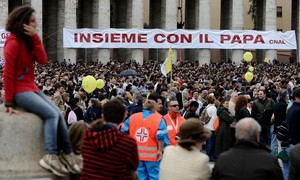

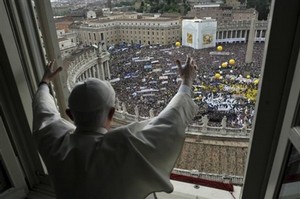

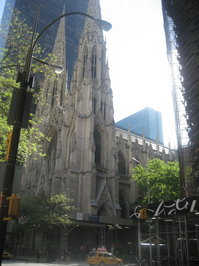


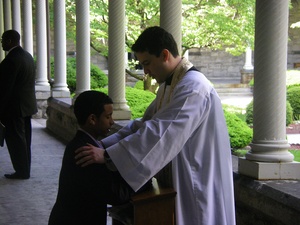
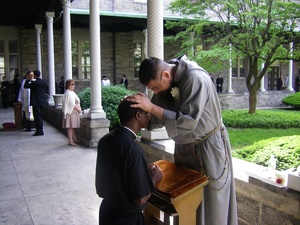
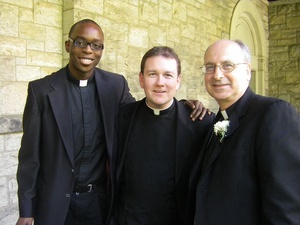

![P5130045[1].JPG](https://communio.stblogs.org/assets_c/2010/05/P5130045[1]-thumb-300x225-6459.jpg)





